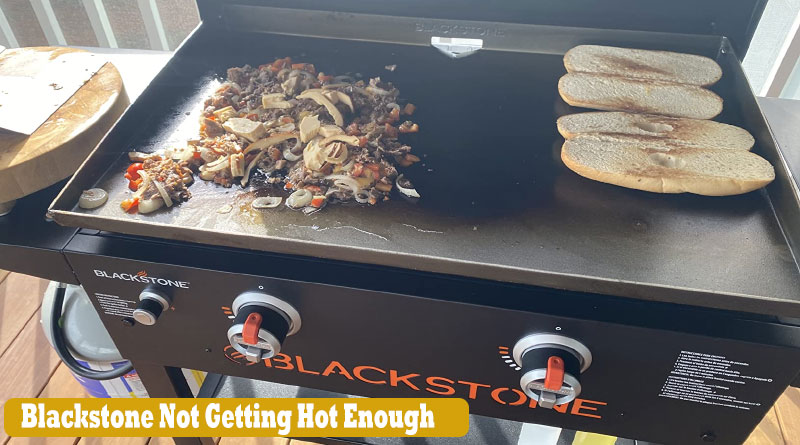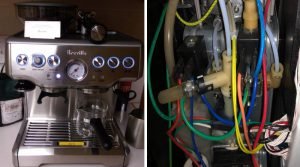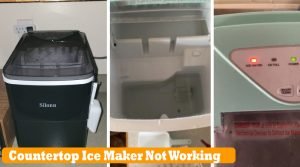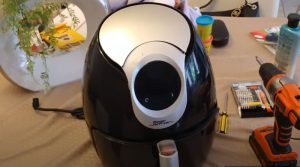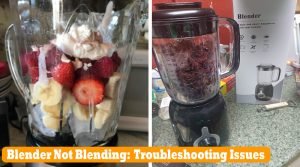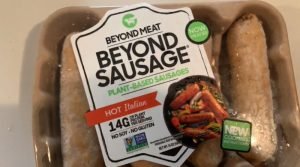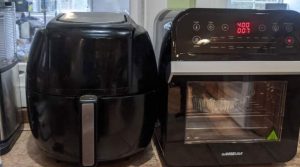Blackstone Not Getting Hot Enough: Expert Troubleshooting Advice
Users occasionally run into an issue where their Blackstone not getting hot enough, which can significantly affect the cooking experience. Blackstone, a renowned name in outdoor cooking appliances, is known for its versatile and durable products.
There’s a special joy in firing up the grill on a beautiful day, the anticipation of sizzling steaks or perfectly seared burgers filling the air with a mouthwatering aroma. For many cooking aficionados, the Blackstone griddle represents the pinnacle of outdoor culinary experience, offering a versatile and efficient platform for creating gourmet dishes.
This article explores the possible reasons behind Blackstone griddle not reaching the desired temperature and provides practical solutions to this common problem.
The Top Reason For Blackstone Not Getting Hot Enough
There could be several reasons why a Blackstone griddle needs to get hotter. Some of the common issues include:
Insufficient Preheating: One of the first checks on your list should be the preheating process. Not allowing griddle to reach the optimal cooking temperature before you begin can cause poor heat distribution and an ineffective cooking surface. A preheated griddle is like a well-trained athlete, ready to perform at its best.
Propane Tank Issues: Gas grills, including the Blackstone range, rely on a steady and sufficient propane supply to create that searing heat. Over time, or due to mishandling, the propane tank can fail to deliver, leaving you in the cold as you wait for the grill to reach temperature.
Airflow Problems: Griddle needs air circulation to achieve and maintain high temperatures. If the airflow around the burners is restricted, heat levels can plummet. Air vents, burner ports, and the surrounding environment ensure the grill’s internal temperature stays ideal.
Faulty Igniter: Another reason could be a defective igniter. If the igniter is not working correctly, it may prevent the griddle from reaching the desired temperature.
Dirty Burners: Dirty burners can also cause the griddle not to heat up adequately. Over time, food residue and grease can build up on the burners, affecting their performance.
Incorrect Installation: Incorrect installation of the griddle can also lead to heating issues. If the griddle has not been installed correctly, it may not heat up as it should.
Regulator Problem: If flames aren’t as high as before, it could be either a clogged propane line or a regulator problem that attaches to the bottle.
Leak Hose and Incorrect Regulator Settings: The Blackstone burner’s low flame may be due to clogged burners, leak or damaged hose, low propane tank pressure, or incorrect regulator settings.
 You don’t want to cook inside all the time, do you?
You don’t want to cook inside all the time, do you?The best portable griddles will allow you to cook delicious meals on the go, with features like adjustable heat control, non-stick surfaces, and easy cleanup, offering ease of use and convenience.
Troubleshooting and Solutions : Blackstone Needing To Get Hotter
You might feel defeated when Blackstone grill isn’t performing as expected, but with patience and these tried-and-true solutions, you can find your way back to cooking excellence on the griddle.
Preheating Tips and Techniques
Patience is a Virtue: Give your griddle the time it needs to preheat properly. Even the most potent Blackstone models can take 10-15 minutes to reach the upper echelons of their heat potential. Remember, good things come to those who wait.
Seasoning Adds Sizzle: Seasoning the griddle protects it from rust and creates a nonstick surface. As you use Blackstone and apply layers of oil, seasoning will enhance the ability of the griddle to retain and distribute heat more evenly, ensuring that every square inch is ready to cook.
Wind Can Win: Consider the wind factor during preheating. Cooking in a draft can significantly lower the temperature of the grill. Position your Blackstone to minimize the effect of the wind, and if necessary, use a grill wind guard to create a more consistent heat environment.
Checking and Replacing Propane Tanks
Sight for Sore Grills: Examine the tank’s condition. Is the exterior clear of frost or ice? It could be a sign of a nearly depleted tank if either is present. Due to a principle in physics known as the Joule-Thomson effect, the gas inside the tank drops significantly in temperature as it expands, causing ice to form. If so, you’ll need to refill or replace the tank.
Leaks and Seals: Check for gas leaks by performing a soap pressure test on the tank’s valve and all connections. You should never see bubbles, as this would indicate a leak that needs to be fixed before using the grill. Also, ensure the tank’s seal is in good condition, as a worn or damaged seal can cause gas to escape, leading to potential underperformance of the grill.
Cleaning and Maintaining Burners and Igniters
Keep It Clean: A clean burner is an efficient burner. Over time, food particles, grease, and spatter can slowly clog burner ports, leading to difficulty lighting and reduced heat. Regular cleaning and maintenance of the burners with a grill brush and using a pipe cleaner for the ports can work wonders.
Spark Some Life: Be sure the igniter is working correctly. If it’s failed, you can use a grill lighter as a temporary fix. However, it’s best to replace the faulty igniter to ensure proper and safe operation of Blackstone grill.
Adjusting Airflow and Ventilation
Open For Business: Make sure the air vents on Blackstone are transparent and open during cooking. If you have a griddle hood, keep the flue or chimney open to allow hot air and steam to escape. Good airflow is critical to maintaining high temperatures and a safe cooking environment.
The Burner Balance: Sometimes, the burner’s flame isn’t suitable. The gas-to-oxygen ratio may be off if you see yellow flames instead of blue. Adjust the air shutter near the burner to achieve a blue flame, which indicates a proper mix and optimal combustion.
Now that you’ve covered the fundamental fixes for a lackluster Blackstone let’s delve into advanced techniques that can transform your griddle into a high-powered heat source.
Advanced Techniques for Maximizing Heat Blackstone
If you’ve followed the initial troubleshooting steps and grill isn’t meeting temperature expectations, it’s time to experiment with more advanced strategies to coax the full fire from Blackstone.
Using a Grill Press
A grill press, also known as a bacon press or plancha, isn’t just for grilled cheese sandwiches and bacon. Using a drill press, you can apply even pressure to foods, ensuring maximum surface contact with the griddle and more rapid, thorough cooking. This added pressure can also help retain the food’s heat, minimizing the overall cooling effect when you add ingredients to the grill.
Seasoning the Griddle Surface
We’ve touched on the importance of seasoning griddle, but to maximize heat and flavor, consider going above and beyond the standard seasoning routine. Apply layers of high smoke point oils and fats such as flaxseed oil or lard, and perform a high-temperature seasoning to create the ultimate nonstick surface that aids heat retention and distribution.
Modifying the Grill for Better Heat Retention
Those comfortable with DIY projects might explore improving their Blackstone’s heat insulation. Adding high-temperature gaskets to seams and joints can help retain heat, and installing a grill blanket designed for propane griddles can dramatically improve efficiency, particularly in colder climates.
With these advanced techniques, you can fine-tune Blackstone to create the kind of sears and caramelization that will satisfy your taste buds. But maintaining these high temperatures requires more than a few tweaks — it’s a way of life for the dedicated griller.
Additional Tips and Considerations for Blackstone Griddle
Grill maintenance isn’t the most glamorous aspect of outdoor cooking but it’s crucial for a consistently fine grilling experience. Here are some final tips and best practices to ensure Blackstone is always ready to deliver.
Proper Cleaning and Maintenance Routines
Make cleaning Blackstone griddle part of post-grill routine. A well-maintained griddle is more likely to reach and maintain higher temperatures. Turn off the propane and allow the grill to cool before cleaning.
Using High-Quality Fuel and Accessories
The propane quality you use can impact the performance of grill, and not all fuels are created equal. Consider using higher grades of propane to maximize the life and efficiency of tank and burners. Additionally, invest in durable and high-quality grilling accessories that will last and contribute to consistent, efficient operations.
Seeking Professional Assistance When Needed
If you’ve exhausted all the DIY methods and Blackstone grill is still struggling with low heat, it may be time to call the professionals. A certified technician can diagnose and fix any major issues beyond the home cook’s reach.
By implementing these comprehensive solutions, you can empower yourself to take control of Blackstone grill’s heat output and unlock its full potential. Remember, grilling is as much a craft as a culinary adventure, and mastering the heat is a crucial step toward becoming a maestro of the Blackstone. With the proper knowledge and some elbow grease, those luscious sears and mouthwatering char lines are well within reach.
So the next time you feel the heat isn’t quite right, don’t panic. Instead, refer back to this guide and tackle the issue with confidence. Enjoy the journey to grilling greatness, and may Blackstone always be hot enough to handle culinary aspirations.
Final Verdict
If Blackstone Not Getting Hot Enough, troubleshooting the propane system, burners, and regulator is crucial. Regular maintenance, proper preheating, and attention to environmental factors can contribute to optimal performance.
If you’ve exhausted all troubleshooting options and the issue persists, contacting Blackstone’s customer support will ensure you receive tailored assistance for griddle model. Remember, a well-maintained griddle enhances cooking performance and extends the longevity of Blackstone appliance.
FAQs: Blackstone Not Getting Hot Enough
Q: Why is my Blackstone not reaching the desired temperature?
A: Several factors can contribute to this issue, such as a faulty regulator, low propane levels, or a clogged burner. Check these components and ensure everything is functioning correctly.
Q: How can I troubleshoot low heat on my Blackstone griddle?
A: Check the propane tank to ensure it’s not empty. If the tank is fine, inspect the regulator and burner for any blockages or damage. Clean the burner ports and ensure proper gas flow.
Q: Is there a specific way to light the Blackstone to ensure it gets hot enough?
A: Follow the manufacturer’s instructions for lighting the Blackstone griddle. Ensure the ignition system is working and the burners are lighting correctly. If not, it may affect the heat output.
Q: Could weather conditions affect the heating performance of my Blackstone griddle?
A: Extreme cold or windy conditions may impact the griddle’s ability to reach and maintain high temperatures. Consider using a wind guard or relocating the griddle to a more sheltered area.
Q: What should I do if the Blackstone griddle heats unevenly?
A: Uneven heating could be caused by uneven propane distribution, clogged burners, or a damaged regulator. Clean the burners, check for obstructions, and ensure the propane flows evenly.
Q: Can the propane type affect the Blackstone griddle’s heat output?
A: While propane is a standard griddle fuel, using high-quality propane with the correct pressure can optimize performance. Check the propane specifications recommended by the manufacturer.
Q: Should I preheat the Blackstone griddle for a specific time?
A: Preheating time may vary, but generally, allowing the griddle to heat 10-15 minutes before cooking is recommended. Consider troubleshooting the components if they’re still not reaching the desired temperature.
Q: Are there specific maintenance steps to prevent low heat issues on the Blackstone griddle?
A: Regularly clean the burners, inspect the propane system for leaks, and follow the manufacturer’s maintenance guidelines. Keeping the griddle in good condition can help prevent heating issues.
Q: What should I do if none of the troubleshooting steps resolves the low heat problem?
A: If persistent issues remain, contact Blackstone customer support for further assistance. They can provide specific guidance based on griddle model and the nature of the problem.

